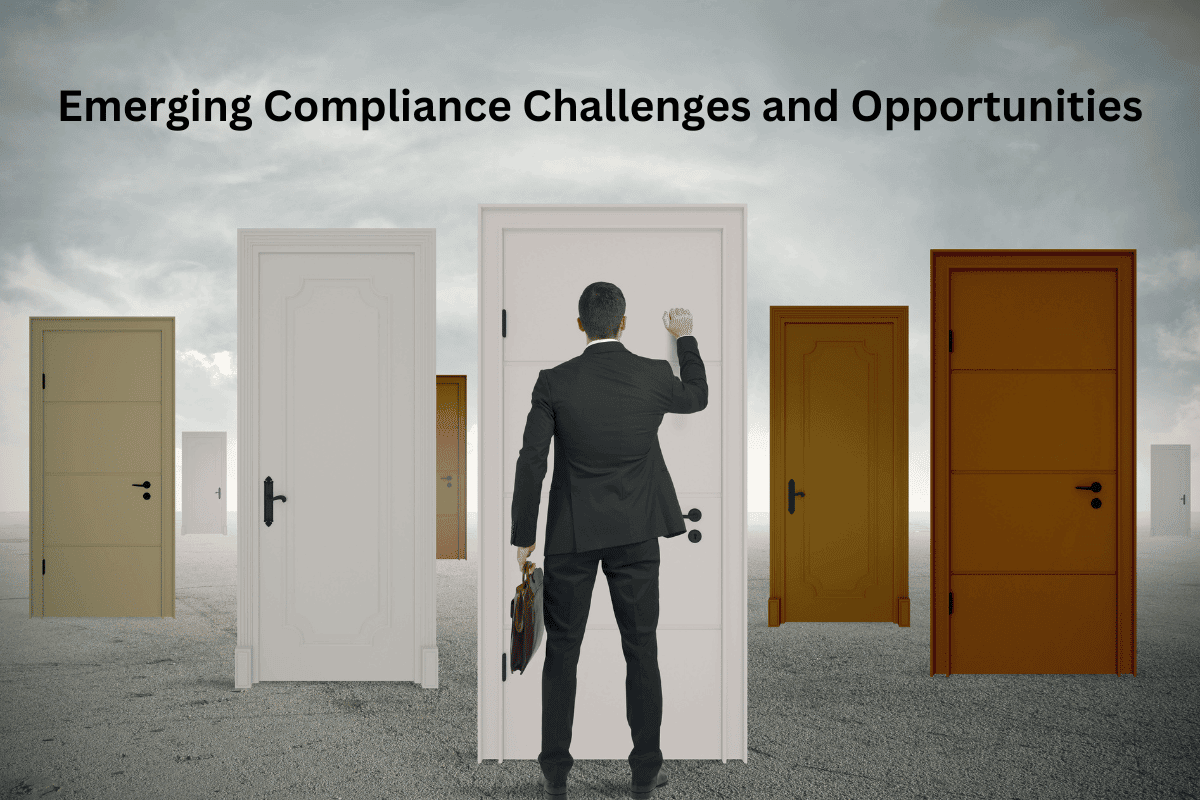Emerging Compliance Challenges and Opportunities: Navigating the Future of Corporate Governance
Compliance in a Digital Age: Navigating Cybersecurity and Data Privacy
Cybersecurity Compliance
As businesses increasingly rely on digital platforms, cloud computing, and interconnected systems, the risk of cyberattacks has escalated. Cybersecurity breaches can result in substantial financial losses, legal liabilities, and severe reputational damage. For compliance professionals, ensuring robust cybersecurity measures are in place is not just about protecting data; it’s about adhering to a growing body of regulations designed to safeguard digital ecosystems.
Regulations such as the General Data Protection Regulation (GDPR) in the European Union and the Cybersecurity Maturity Model Certification (CMMC) in the United States set strict requirements for how organizations must protect sensitive information. These regulations mandate that organizations implement comprehensive security controls, conduct regular risk assessments, and report breaches within specified timeframes.
The challenge for organizations is twofold: first, staying ahead of evolving cyber threats, and second, ensuring that their cybersecurity practices are compliant with increasingly complex regulatory frameworks. This requires a proactive approach that includes continuous monitoring of cybersecurity risks, regular updates to security protocols, and thorough training for employees on the latest cybersecurity threats and compliance requirements.
Data Privacy Compliance
Data privacy has become a paramount concern for organizations across the globe. The proliferation of data-driven technologies, such as artificial intelligence and big data analytics, has raised questions about how personal data is collected, stored, and used. Regulations like GDPR, the California Consumer Privacy Act (CCPA), and Brazil’s General Data Protection Law (LGPD) impose stringent requirements on organizations regarding data privacy.
Compliance with data privacy regulations involves several key components:
- Data Minimization: Organizations must limit the collection of personal data to what is necessary for specific, legitimate purposes.
- Consent Management: Regulations often require organizations to obtain explicit consent from individuals before collecting or processing their personal data.
- Data Subject Rights: Regulations like GDPR grant individuals specific rights over their personal data, such as the right to access, rectify, and delete their data.
- Cross-Border Data Transfers: Data privacy regulations often include restrictions on transferring personal data across borders, particularly to countries with different levels of data protection.
The opportunity for organizations lies in building trust with customers and stakeholders by demonstrating a commitment to data privacy. Organizations that prioritize data privacy compliance can differentiate themselves in the marketplace, reduce the risk of legal penalties, and foster long-term customer loyalty.
Environmental, Social, and Governance (ESG) Compliance: Aligning Business with Societal Expectations
Environmental Compliance
Environmental compliance involves adhering to laws and regulations that govern how organizations impact the environment. This includes regulations related to pollution, waste management, energy efficiency, and carbon emissions. With the growing urgency of climate change, governments around the world are implementing stricter environmental regulations, such as the European Union’s Green Deal and the Paris Agreement’s commitments to reducing greenhouse gas emissions.
For organizations, environmental compliance requires a comprehensive approach to managing environmental risks and opportunities. This includes conducting environmental impact assessments, setting measurable sustainability goals, and implementing environmental management systems that track and report on performance.
The opportunity in environmental compliance lies in embracing sustainability as a core business strategy. Organizations that proactively reduce their environmental footprint can benefit from cost savings, improved brand reputation, and access to new markets. Moreover, by aligning with global sustainability goals, businesses can attract investment from environmentally conscious investors and meet the expectations of eco-aware consumers.
Social Compliance
Social compliance focuses on how organizations treat their employees, suppliers, and communities. It encompasses issues such as labor rights, diversity and inclusion, health and safety, and human rights. Social compliance is increasingly scrutinized by stakeholders who expect organizations to operate ethically and contribute positively to society.
Regulations and frameworks such as the United Nations Guiding Principles on Business and Human Rights (UNGPs) and the International Labour Organization (ILO) standards provide guidelines for social compliance. Organizations must ensure that their operations, as well as those of their supply chains, adhere to these standards.
One of the challenges of social compliance is managing the complexity of global supply chains. Organizations must conduct thorough due diligence to identify and address risks related to forced labor, child labor, and unsafe working conditions. This often requires collaboration with suppliers, third-party audits, and the implementation of corrective action plans.
The opportunity in social compliance is significant. By prioritizing ethical practices, organizations can build stronger relationships with stakeholders, enhance employee engagement and retention, and create a competitive advantage. Companies that demonstrate leadership in social responsibility are often rewarded with greater customer loyalty and positive brand recognition.
Governance Compliance
Governance compliance refers to the systems and processes that ensure organizations are managed effectively and ethically. This includes adherence to laws and regulations related to corporate governance, such as those governing financial reporting, board accountability, and shareholder rights.
Effective governance compliance involves establishing clear policies and procedures, ensuring transparency in decision-making, and maintaining robust internal controls. It also requires a commitment to ethical leadership, with boards and executives setting the tone for the organization’s culture and values.
Governance compliance is not just about avoiding legal penalties; it’s about building trust with stakeholders. Organizations with strong governance practices are more likely to attract investment, retain top talent, and maintain long-term business success.
The opportunity in governance compliance lies in creating a resilient organization that can adapt to changing regulatory requirements and stakeholder expectations. By fostering a culture of integrity and accountability, organizations can navigate challenges more effectively and capitalize on opportunities for growth.
Anti-Corruption and Bribery Prevention: Safeguarding Integrity in Business
Corruption and bribery remain pervasive challenges in global business, posing significant risks to organizations, including legal penalties, financial losses, and reputational damage. Anti-corruption and bribery prevention are critical components of compliance programs, particularly for organizations operating in regions with high corruption risks.
Regulatory Frameworks and Standards
Several international frameworks and regulations govern anti-corruption and bribery prevention. These include the Foreign Corrupt Practices Act (FCPA) in the United States, the UK Bribery Act, and the OECD Anti-Bribery Convention. These regulations impose strict requirements on organizations to prevent and detect corrupt practices, including bribery of foreign officials, facilitation payments, and corporate gift-giving.
Compliance with anti-corruption regulations requires organizations to implement comprehensive policies and procedures that address the following key areas:
- Risk Assessment: Organizations must conduct regular risk assessments to identify areas where they are most vulnerable to corruption and bribery.
- Internal Controls: Effective internal controls are essential for preventing and detecting corrupt practices.
- Training and Awareness: Regular training and awareness programs are critical for ensuring that employees understand the risks of corruption and bribery and know how to comply with relevant laws and policies.
- Whistleblower Protections: Organizations must provide safe and confidential channels for employees to report suspected corruption or bribery.
Challenges and Opportunities
One of the challenges in anti-corruption compliance is the need to balance legal requirements with cultural differences across regions. Practices that may be acceptable in one country can be considered corrupt in another, making it difficult for multinational organizations to navigate these complexities.
Despite these challenges, there are significant opportunities for organizations that demonstrate a commitment to anti-corruption and bribery prevention. Organizations that prioritize integrity and ethical behavior are more likely to gain the trust of investors, customers, and business partners. Furthermore, by proactively addressing corruption risks, organizations can avoid costly legal battles and protect their reputation.
In an era of increasing transparency and stakeholder scrutiny, organizations that lead in anti-corruption compliance can differentiate themselves in the marketplace and build long-term, sustainable success.
Emerging Regulatory Trends and Their Impact: Staying Ahead of the Curve
The regulatory landscape is constantly evolving, driven by technological advancements, societal changes, and political developments. Staying ahead of emerging regulatory trends is essential for organizations to maintain compliance and capitalize on new opportunities.
Regulatory Trends in the Digital Age
The rise of digital technologies has led to the emergence of new regulatory trends, particularly in the areas of cybersecurity, data privacy, and artificial intelligence (AI). As these technologies become increasingly integrated into business operations, governments worldwide are implementing regulations to address the associated risks and challenges. This evolving regulatory landscape presents both challenges and opportunities for organizations, requiring them to stay vigilant and adapt to new requirements.
Cybersecurity Regulations
Cybersecurity has become a focal point of regulatory attention due to the growing frequency and sophistication of cyberattacks. Governments are introducing more stringent cybersecurity regulations to protect critical infrastructure, safeguard sensitive data, and ensure the resilience of digital systems.
These regulations often require organizations to implement advanced security measures, such as multi-factor authentication, encryption, and incident response protocols. They may also mandate regular cybersecurity audits, risk assessments, and reporting obligations. Non-compliance with these regulations can result in significant penalties, including fines, legal liabilities, and reputational damage.
For organizations, staying ahead of cybersecurity regulations means continuously updating their security practices, investing in cutting-edge technologies, and training employees on cybersecurity awareness. By proactively addressing cybersecurity risks, organizations can protect themselves from cyber threats and demonstrate compliance to regulators and stakeholders.
Data Privacy Regulations
Data privacy remains a critical regulatory focus as the amount of personal data collected and processed by organizations continues to grow. The introduction of comprehensive data privacy laws, such as the European Union‘s General Data Protection Regulation (GDPR), the California Consumer Privacy Act (CCPA), and Brazil’s General Data Protection Law (LGPD), has set a high standard for data protection globally.
These regulations require organizations to adopt robust data protection practices, including obtaining explicit consent for data collection, ensuring data minimization, and enabling data subjects to exercise their rights to access, rectify, or delete their personal data. Additionally, organizations must be prepared to report data breaches within tight timeframes and demonstrate compliance with privacy-by-design principles.
The challenge for organizations is not only to comply with existing data privacy laws but also to anticipate and prepare for new regulations that may arise as digital technologies evolve. For instance, the growing use of AI and machine learning in data processing has sparked regulatory discussions around algorithmic transparency, fairness, and accountability.
Artificial Intelligence and Emerging Technologies
Artificial intelligence (AI) and other emerging technologies, such as blockchain and the Internet of Things (IoT), are transforming industries and creating new opportunities for innovation. However, these technologies also raise complex ethical, legal, and regulatory issues, prompting governments to consider new frameworks to govern their use.
For example, the European Union’s proposed Artificial Intelligence Act seeks to establish a regulatory framework for AI systems, categorizing them based on their risk levels and imposing corresponding compliance requirements. High-risk AI systems, such as those used in healthcare, finance, and law enforcement, would be subject to stringent oversight, including requirements for transparency, accountability, and human oversight.
Similarly, the use of blockchain technology and cryptocurrencies has led to the development of new regulations aimed at preventing money laundering, fraud, and other illicit activities. The Financial Action Task Force (FATF) has issued guidelines for the regulation of virtual assets, and many countries are enacting laws to govern cryptocurrency exchanges and transactions.
For organizations, staying ahead of regulations related to AI and emerging technologies requires a proactive approach to compliance. This includes conducting thorough risk assessments, implementing ethical AI practices, and engaging with regulators to stay informed about upcoming changes. Organizations that successfully navigate these challenges can leverage emerging technologies to drive innovation while ensuring compliance with evolving regulatory standards.
The Impact of Regulatory Trends on Business Strategy
The rapid pace of regulatory change in the digital age has significant implications for business strategy. Organizations must not only comply with existing regulations but also anticipate future trends and adapt their strategies accordingly. This requires a holistic approach to compliance that integrates regulatory considerations into every aspect of the business.
One of the key challenges for organizations is managing the complexity of global regulations. As regulatory frameworks vary across jurisdictions, multinational organizations must navigate a patchwork of laws and requirements. This necessitates a coordinated approach to compliance, with centralized oversight and local expertise to ensure adherence to both global and regional regulations.
The opportunity for organizations lies in using compliance as a strategic advantage. By staying ahead of regulatory trends, businesses can position themselves as leaders in their industries, build trust with stakeholders, and mitigate risks. Moreover, proactive compliance can open up new markets, attract investment, and enhance the organization’s reputation.
To achieve this, organizations should invest in regulatory intelligence and compliance management systems that provide real-time updates on regulatory changes and enable efficient compliance tracking. Additionally, fostering a culture of compliance, where employees at all levels are aware of and committed to regulatory requirements, is essential for long-term success.
Conclusion
The compliance landscape is evolving rapidly, driven by advances in digital technology, changing societal expectations, and emerging regulatory frameworks. Organizations face significant challenges in navigating this complex environment, but they also have opportunities to enhance their resilience, build trust with stakeholders, and create competitive advantages.
By focusing on key areas such as cybersecurity, data privacy, ESG compliance, and anti-corruption, organizations can address emerging compliance challenges and capitalize on new opportunities. Staying ahead of regulatory trends requires a proactive and strategic approach to compliance, with a commitment to continuous improvement and innovation.
As the regulatory environment continues to evolve, organizations that embrace these challenges and opportunities will be well-positioned to thrive in the future. Compliance is no longer just about avoiding penalties; it is about building a sustainable and ethical business that can adapt to change and succeed in an increasingly complex world.








